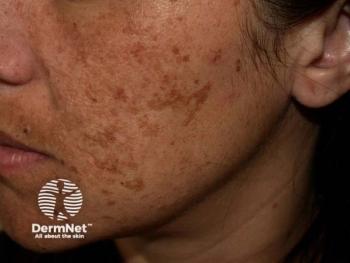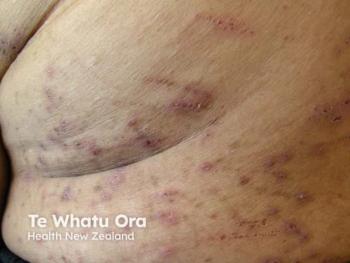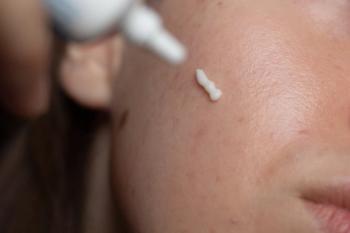
- Dermatology Times, August 2025 (Vol. 46. No. 08)
- Volume 46
- Issue 08
It’s Time to Treat Moderate Psoriasis Seriously
Key Takeaways
- Moderate psoriasis can significantly impair quality of life, prompting a re-evaluation of systemic treatment eligibility criteria.
- IL-23 inhibitors demonstrate superior efficacy over PDE4 inhibitors in achieving higher clearance rates in moderate psoriasis.
Explore the evolving landscape of moderate psoriasis treatment, emphasizing patient-centered care and innovative therapies for improved quality of life.
Our understanding of moderate plaque psoriasis is evolving. Once narrowly defined by body surface area (BSA) and composite severity scores, moderate psoriasis is increasingly recognized as a disease category that can significantly impair quality of life, even when lesion extent is limited. This shift has been accompanied by new classification frameworks, more inclusive systemic treatment eligibility criteria, and growing consensus around meaningful long-term treatment targets such as on-treatment remission.
Rethinking Systemic Eligibility
Traditionally, systemic therapy was reserved for patients with Psoriasis Area and Severity Index (PASI) scores above 10 or at least 10% BSA involvement. However, these thresholds do not fully reflect disease burden in patients with involvement of sensitive or functionally critical areas, such as the scalp, face, genitals, palms, soles, and nails. The International Psoriasis Council (IPC) has proposed a reclassification that considers systemic therapy appropriate for patients with high-impact site involvement, BSA greater than 10%, or inadequate response to topical therapies.1
This redefinition is supported by real-world evidence. Data from the CorEvitas Psoriasis Registry show that a substantial proportion of patients initiating systemic therapy have 10% or less BSA involvement, often because their disease affects visible or high-impact sites.2 Similarly, the UPLIFT survey—a multinational cross-sectional study— found that patients with limited BSA but psoriasis in sensitive areas report disproportionately high levels of pruritus, pain, functional limitation, and emotional distress.3 These findings challenge traditional severity cutoffs and emphasize the need to assess treatment eligibility based on impact, not just extent.
Aligning Treatment Choice With Patient Needs
Once systemic therapy is deemed appropriate, selecting the right treatment involves careful consideration of clinical characteristics, comorbidities, patient preferences, and treatment goals. Increasingly, there is recognition that many systemic eligible patients with moderate psoriasis may benefit from therapies that offer greater depth and durability of response.
The IMMpulse study (
These findings underscore that moderate disease severity does not preclude the need—or the benefit—of highly effective treatment. For patients with high-impact site involvement or inadequate response to initial therapy, timely consideration of therapies that can induce higher clearance levels may improve both disease control and quality of life.
On-Treatment Remission as a Shared Benchmark
The
New Oral Agents on the Horizon
The psoriasis treatment landscape continues to expand with promising oral therapies. Zasocitinib (Takeda), a selective TYK2 inhibitor, demonstrated PASI 75 in 67%, PASI 90 in 46%, and PASI 100 in 33% of patients at week 12 in a phase 2b trial.6 Icotrokinra (Protagonist Therapeutics and Janssen Biotech), a first-in-class oral IL-23 receptor antagonist, achieved 65% IGA 0/1 and 50% PASI 90 at week 16 in the phase 3 ICONIC-LEAD trial (
Considering Disease Trajectory
Emerging data also suggest that early treatment decisions may in uence longer-term disease trajectory. A recent population-based analysis of more than 7000 patients with psoriasis found that those initiating IL-23 inhibitors had a significantly lower incidence of new-onset in flammatory arthritis than those starting TNF or IL-17 inhibitors.8 Although additional studies are needed to confirm causality, this observation raises important questions about the potential disease-modifying properties of early IL-23 inhibition, particularly in patients at elevated risk for psoriatic arthritis (PsA). This reinforces the broader need to take a proactive, longitudinal view of psoriasis management. Treatment goals should extend beyond skin clearance to include comorbidity prevention (especially PsA), functional preservation, and patient-reported outcomes.
The Path Forward
Moderate plaque psoriasis is not a trivial condition. Even with limited BSA involvement, disease affecting high-impact sites can profoundly affect quality of life. Also, PsA can exist in patients with plaque psoriasis with limited BSA involvement. With updated eligibility criteria, strong evidence such as the IMMpulse study, evolving benchmarks for ontreatment remission, and an expanding pipeline of effective oral therapies, dermatologists now have the tools to deliver patient-centered, goal-directed care. The era of undertreating moderate psoriasis must end. With new data, better de finitions, and clearer treatment targets, we have the tools to raise expectations and outcomes. It is time to match our clinical strategy with the realities our patients live every day.
References
- Strober BE, Blauvelt A, van de Kerkhof PC, et al. International Psoriasis Council psoriasis disease severity reclassi fication: update on validity, acceptance, and implementation. J Am Acad Dermatol. Published online June 6, 2025. doi:10.1016/j.jaad.2025.05.1445
- Armstrong AW, Feldman SR, Fitzgerald T, et al. Patient reported outcomes by baseline body surface area involvement among individuals initiating biologic therapy: results from the CorEvitas Psoriasis Registry. Dermatol Ther (Heidelb). 2025;15(8):2117-2130. doi:10.1007/s13555- 025-01456-5
- Merola JF, Ogdie A, Gottlieb AB, et al. Patient and physician perceptions of psoriatic disease in the United States: results from the UPLIFT survey. Dermatol Ther (Heidelb). 2023;13(6):1329-1346. doi:10.1007/s13555-023- 00929-9
- Stein Gold LF, Bagel J, Tyring SK, et al. Comparison of risankizumab and apremilast for the treatment of adults with moderate plaque psoriasis eligible for systemic therapy: results from a randomized, open-label, assessor blinded phase IV study (IMMpulse). Br J Dermatol. 2023;189(5):540-552. doi:10.1093/bjd/ljad252
- Armstrong AW, Gondo GC, Merola JF, et al. Defining on-treatment remission in plaque psoriasis: a consensus statement from the National Psoriasis Foundation. JAMA Dermatol. Published online June 18, 2025. doi:10.1001/ jamadermatol.2025.1625
- Armstrong AW, Gooderham M, Lynde C, et al. Tyrosine kinase 2 inhibition with zasocitinib (TAK-279) in psoriasis: a randomized clinical trial. JAMA Dermatol. 2024;160(10):1066-1074. doi:10.1001/jamadermatol.2024.2701
- Icotrokinra results show potential to set a new standard of treatment in plaque psoriasis. News release. Johnson & Johnson. March 8, 2025. Accessed July 14, 2025. https://www.jnj.com/media-center/press-releases/ icotrokinra-results-show-potential-to-set-a-new-standard-of-treatment-in-plaque-psoriasis
- Strober B, Soliman AM, Li C, Patel M, Unigwe I, Gisondi P. Risk of developing inflammatory arthritis in patients with psoriasis initiating treatment with biologics: a population-based analysis. J Am Acad Dermatol. 2024;91(6):1143-1149. doi:10.1016/j.jaad.2024.06.106
Articles in this issue
4 months ago
Examining Bond-Building Hair Care Treatments4 months ago
Dermatology Times August 2025 Print RecapNewsletter
Like what you’re reading? Subscribe to Dermatology Times for weekly updates on therapies, innovations, and real-world practice tips.


















